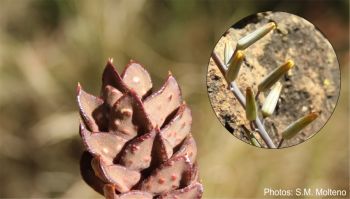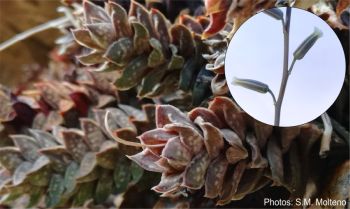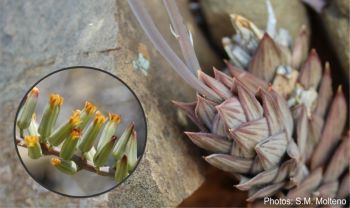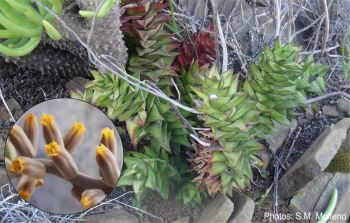Astroloba subg. Astroloba sect. Astroloba
Astroloba subgenus Astroloba section Astroloba
Family: Asphodelaceae
Common names:
Introduction
The species in this section have leaves that are often tuberculed, with one margin of each leaf usually losing its identity near the leaf apex. The relatively large divergence angle (±144°–151°) arranges the leaves in five ranks that appear either vertical or spiralling in the same direction as the generative spiral (although some Astroloba tenax specimens are exceptions). The inflorescence is often branched, and the flowers have dull grey or green perianth tubes with yellow lobes (although some Astroloba cremnophila specimens have cream lobes). The preferred habitat of all species in this section is relatively steep rocky slopes, in the far southwestern part of the Great Karoo. They occur from the Ceres-Tanqua Karoo in the west, to Prince Albert in the east.
Species

Astroloba bullulata (Jacq.) Uitewaal can be distinguished by its ovate leaves that have a dull matt surface, usually with transversely arranged tubercles; relatively lacking in leaf fibres; one margin of each leaf losing its identity near the incurved leaf tip that also has a prominent keel; the flowers that are born on thin pedicels, with yellow lobes, and perianth segments that are not inflated next to midrib and smooth to the touch. It occurs on rocky slopes in karroid vegetation in a very cold and arid winter-rainfall part of the Western Cape, and has one of the western-most distribution range in genus. This species flowers in early summer, from November to December.

Astroloba cremnophila Van Jaarsv. can be distinguished by its spreading leaves that have a dull matt surface, usually with faint longitudinal lines and sparse tubercles; one margin of each leaf losing its identity near the incurved leaf tip that also has a prominent keel; the flowers that are born on thin pedicels, with grey-green or cream lobes, and perianth segments that are not inflated next to midrib and smooth to the touch. It grows pendent from cliff faces in thicket vegetation of the Groot Swartberg in the Western Cape. It has the most restricted distribution of the astrolobas. This species flowers in summer, from November to April.

Astroloba pentagona (Haw.) Uitewaal can be distinguished by its relatively straighter and more erect leaves that have a pale matt surface, with longitudinal lines and sometimes with tubercles arranged longitudinally along the lines; by one margin of each leaf losing its identity near the leaf tip that also has a prominent keel; by the flowers that are born on thin pedicels, with pale yellow lobes, and perianth segments that are not inflated next to midrib and smooth to the touch. It occurs on rocky slopes in karroid vegetation between the Koup and Moordenaars Karoo, as well as the northern foothills of the Klein Swartberg mountains. This species flowers in early to midsummer, from November to January.

Astroloba tenax Molteno, Van Jaarsv. & Gideon F.Sm. var. tenax can be distinguished by its splayed leaves that have a glossy surface, sometimes with faint longitudinal lines and occasional tubercles; by one margin of each leaf sometimes losing its identity near the leaf tip; by the flowers that are born on thin pedicels, with yellow lobes, and grey perianth segments that are not inflated next to midrib and smooth to the touch. It occurs in succulent karroo vegetation west of Prince Albert in the Western Cape. This variety flowers in early to midsummer from November to January.

Astroloba tenax var. moltenoi Gideon F.Sm. & Van Jaarsv. can be distinguished from A. tenax var. tenax by being more robust and larger in all aspects. It occurs in succulent karoo vegetation northeast of Prince Albert in the Western Cape. This variety flowers in early summer, from November to December.
Credits
Go to Astroloba genus page
Ronell R Klopper
Foundational Biodiversity Sciences: SANBI,
Gideon F Smith
Nelson Mandela Metropolitan University
and
Steven Molteno
Molteno Botanical Consulting.
September 2023
Plant Attributes:
Plant Type:
SA Distribution:
Soil type:
Flowering season:
PH:
Flower colour:
Aspect:
Gardening skill:
Special Features:
Horticultural zones






Rate this article
Article well written and informative
Rate this plant
Is this an interesting plant?
Login to add your Comment
Back to topNot registered yet? Click here to register.